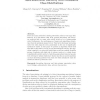Free Online Productivity Tools
i2Speak
i2Symbol
i2OCR
iTex2Img
iWeb2Print
iWeb2Shot
i2Type
iPdf2Split
iPdf2Merge
i2Bopomofo
i2Arabic
i2Style
i2Image
i2PDF
iLatex2Rtf
Sci2ools
AUSAI
2003
Springer
2003
Springer
Association Rule Discovery with Unbalanced Class Distributions
There are many methods for finding association rules in very large data. However it is well known that most general association rule discovery methods find too many rules, which include a lot of uninteresting rules. Furthermore, the performances of many such algorithms deteriorate when the minimum support is low. They fail to find many interesting rules even when support is low, particularly in the case of significantly unbalanced classes. In this paper we present an algorithm which finds association rules based on a set of new interestingness criteria. The algorithm is applied to a real-world health data set and successfully identifies groups of patients with high risk of adverse reaction to certain drugs. A statistically guided method of selecting appropriate features has also been developed. Initial results have shown that the proposed algorithm can find interesting patterns from data sets with unbalanced class distributions without performance loss.
Artificial Intelligence | Association Rule Discovery | Association Rules | AUSAI 2003 | Uninteresting Rules |
| Added | 06 Jul 2010 |
| Updated | 06 Jul 2010 |
| Type | Conference |
| Year | 2003 |
| Where | AUSAI |
| Authors | Lifang Gu, Jiuyong Li, Hongxing He, Graham J. Williams, Simon Hawkins, Chris Kelman |
Comments (0)

